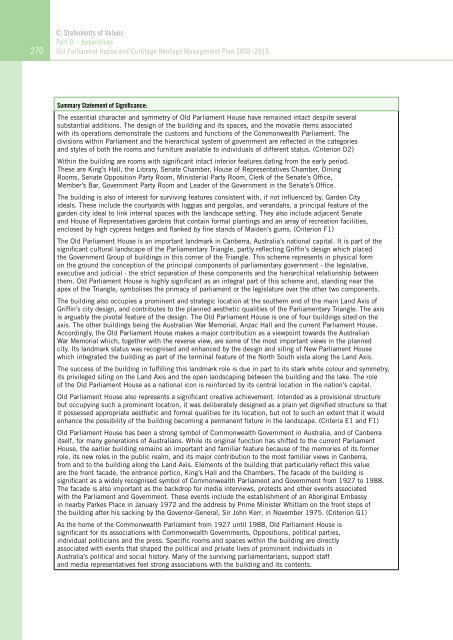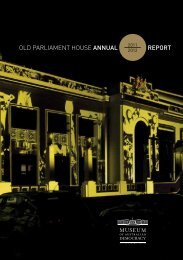OLD PARLIAMENT HOUSE AND CURTILAGE HERITAGE MANAGEMENT PLAN 2008–2013
Heritage Management Plan 2008-2013 - Museum of Australian ...
Heritage Management Plan 2008-2013 - Museum of Australian ...
- No tags were found...
Create successful ePaper yourself
Turn your PDF publications into a flip-book with our unique Google optimized e-Paper software.
C. Statements of Values<br />
Part D – Appendices<br />
270 Old Parliament House and Curtilage Heritage Management Plan <strong>2008–2013</strong><br />
Summary Statement of Significance:<br />
The essential character and symmetry of Old Parliament House have remained intact despite several<br />
substantial additions. The design of the building and its spaces, and the movable items associated<br />
with its operations demonstrate the customs and functions of the Commonwealth Parliament. The<br />
divisions within Parliament and the hierarchical system of government are reflected in the categories<br />
and styles of both the rooms and furniture available to individuals of different status. (Criterion D2)<br />
Within the building are rooms with significant intact interior features dating from the early period.<br />
These are King’s Hall, the Library, Senate Chamber, House of Representatives Chamber, Dining<br />
Rooms, Senate Opposition Party Room, Ministerial Party Room, Clerk of the Senate’s Office,<br />
Member’s Bar, Government Party Room and Leader of the Government in the Senate’s Office.<br />
The building is also of interest for surviving features consistent with, if not influenced by, Garden City<br />
ideals. These include the courtyards with loggias and pergolas, and verandahs, a principal feature of the<br />
garden city ideal to link internal spaces with the landscape setting. They also include adjacent Senate<br />
and House of Representatives gardens that contain formal plantings and an array of recreation facilities,<br />
enclosed by high cypress hedges and flanked by fine stands of Maiden’s gums. (Criterion F1)<br />
The Old Parliament House is an important landmark in Canberra, Australia’s national capital. It is part of the<br />
significant cultural landscape of the Parliamentary Triangle, partly reflecting Griffin’s design which placed<br />
the Government Group of buildings in this corner of the Triangle. This scheme represents in physical form<br />
on the ground the conception of the principal components of parliamentary government - the legislative,<br />
executive and judicial - the strict separation of these components and the hierarchical relationship between<br />
them. Old Parliament House is highly significant as an integral part of this scheme and, standing near the<br />
apex of the Triangle, symbolises the primacy of parliament or the legislature over the other two components.<br />
The building also occupies a prominent and strategic location at the southern end of the main Land Axis of<br />
Griffin’s city design, and contributes to the planned aesthetic qualities of the Parliamentary Triangle. The axis<br />
is arguably the pivotal feature of the design. The Old Parliament House is one of four buildings sited on the<br />
axis. The other buildings being the Australian War Memorial, Anzac Hall and the current Parliament House.<br />
Accordingly, the Old Parliament House makes a major contribution as a viewpoint towards the Australian<br />
War Memorial which, together with the reverse view, are some of the most important views in the planned<br />
city. Its landmark status was recognised and enhanced by the design and siting of New Parliament House<br />
which integrated the building as part of the terminal feature of the North South vista along the Land Axis.<br />
The success of the building in fulfilling this landmark role is due in part to its stark white colour and symmetry,<br />
its privileged siting on the Land Axis and the open landscaping between the building and the lake. The role<br />
of the Old Parliament House as a national icon is reinforced by its central location in the nation’s capital.<br />
Old Parliament House also represents a significant creative achievement. Intended as a provisional structure<br />
but occupying such a prominent location, it was deliberately designed as a plain yet dignified structure so that<br />
it possessed appropriate aesthetic and formal qualities for its location, but not to such an extent that it would<br />
enhance the possibility of the building becoming a permanent fixture in the landscape. (Criteria E1 and F1)<br />
Old Parliament House has been a strong symbol of Commonwealth Government in Australia, and of Canberra<br />
itself, for many generations of Australians. While its original function has shifted to the current Parliament<br />
House, the earlier building remains an important and familiar feature because of the memories of its former<br />
role, its new roles in the public realm, and its major contribution to the most familiar views in Canberra,<br />
from and to the building along the Land Axis. Elements of the building that particularly reflect this value<br />
are the front facade, the entrance portico, King’s Hall and the Chambers. The facade of the building is<br />
significant as a widely recognised symbol of Commonwealth Parliament and Government from 1927 to 1988.<br />
The facade is also important as the backdrop for media interviews, protests and other events associated<br />
with the Parliament and Government. These events include the establishment of an Aboriginal Embassy<br />
in nearby Parkes Place in January 1972 and the address by Prime Minister Whitlam on the front steps of<br />
the building after his sacking by the Governor-General, Sir John Kerr, in November 1975. (Criterion G1)<br />
As the home of the Commonwealth Parliament from 1927 until 1988, Old Parliament House is<br />
significant for its associations with Commonwealth Governments, Oppositions, political parties,<br />
individual politicians and the press. Specific rooms and spaces within the building are directly<br />
associated with events that shaped the political and private lives of prominent individuals in<br />
Australia’s political and social history. Many of the surviving parliamentarians, support staff<br />
and media representatives feel strong associations with the building and its contents.




